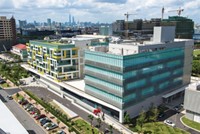Advertisement
Grab your lab coat. Let's get started
Welcome!
Welcome!
Create an account below to get 6 C&EN articles per month, receive newsletters and more - all free.
It seems this is your first time logging in online. Please enter the following information to continue.
As an ACS member you automatically get access to this site. All we need is few more details to create your reading experience.
Not you? Sign in with a different account.
Not you? Sign in with a different account.
ERROR 1
ERROR 1
ERROR 2
ERROR 2
ERROR 2
ERROR 2
ERROR 2
Password and Confirm password must match.
If you have an ACS member number, please enter it here so we can link this account to your membership. (optional)
ERROR 2
ACS values your privacy. By submitting your information, you are gaining access to C&EN and subscribing to our weekly newsletter. We use the information you provide to make your reading experience better, and we will never sell your data to third party members.
Pharmaceuticals
Novartis And MIT Study Drug Production
Ten-year agreement targets continuous pharmaceutical manufacturing
by Rick Mullin
October 2, 2007

Novartis and MIT have launched a partnership aimed at transforming pharmaceutical manufacturing. Novartis hopes the pact will allow it to convert its drug production infrastructure from multisite batch operations to continuous ones that consolidate chemical synthesis, formulation, and packaging in one location.
The drug company is investing $65 million in research at MIT over the 10-year period of the partnership. The project will involve seven to 10 MIT faculty members, as well as students, postdoctoral fellows, MIT staff scientists, and Novartis engineers and scientists. Research will be conducted primarily through MIT Ph.D. programs and then transferred to Novartis for further development to industrial-scale projects.
"This partnership demonstrates our commitment to lead not only in discovering innovative treatments for patients, but also in improving manufacturing processes, which are critical to ensuring a high-quality, efficient, and reliable supply of medicines to patients," says Novartis CEO Daniel Vasella.
Thomas Van Larr, head of global technology operations for Novartis, says the drug industry's heritage in batch manufacturing stems in part from the relatively small volumes of high-value active ingredients needed to make drugs. However, many products, such as Novartis' blood pressure medication Diovan, are produced at a volume that could support continuous chemical production, according to Van Larr.
"To truly go continuous is going to involve a massive effort employing new technology," he says. The 10-year project, he adds, is designed to develop technologies that will be implemented over a longer time frame, up to 20 years.
Most major drug companies are exploring options for continuous processing, and some are working together. Pfizer, GlaxoSmithKline, and AstraZeneca, for example, are members of a U.K.-based manufacturing innovation consortium called Britest that includes academic partners (C&EN, Jan. 22, page 11).
But Bernhardt L. Trout, associate professor of chemical engineering at MIT and director of the Novartis MIT Center for Continuous Manufacturing, says the exclusive partnership means researchers can focus more directly on intense process development. "This project is going to drive the industry," Trout says. "Other companies will follow suit."
Continuous processing is expected to reduce production costs and improve environmental performance. The new technologies will also impact drug development, according to Van Larr, who notes that Novartis drug development scientists will be involved with research at MIT.
MIT President Susan Hockfield has put her stamp of approval on the partnership. "The Novartis-MIT Center for Continuous Manufacturing has the potential to revolutionize drug development and production," she says. "We are delighted to collaborate with Novartis to help improve the way that drugs are manufactured so that patients have quicker and more reliable access to the medication they need."




Join the conversation
Contact the reporter
Submit a Letter to the Editor for publication
Engage with us on Twitter